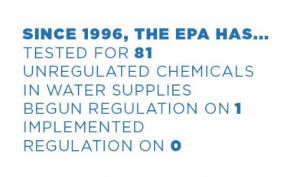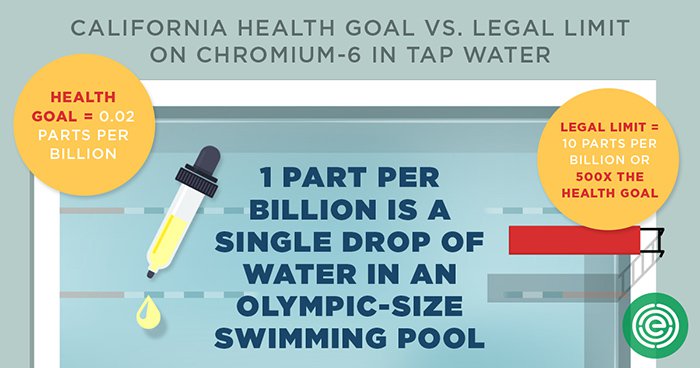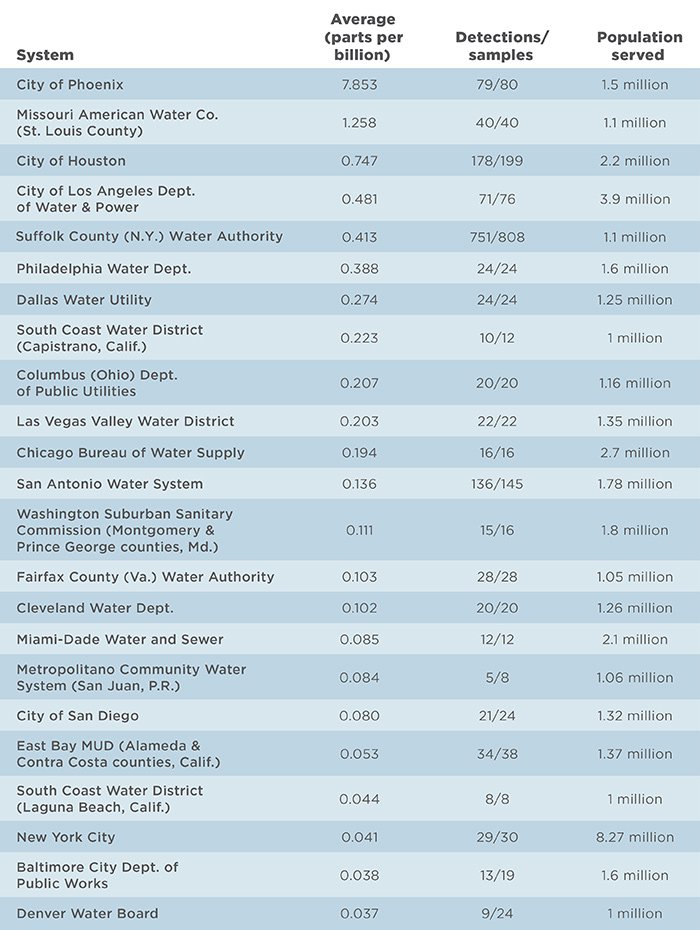It seems crazy. How hard can it be to pump healthy water through the pipes leading to our homes and businesses? It’s not like we’re some third-world country. And the technology involved in purifying water is not some recent discovery. Yet one thing you take for granted — that your drinking water is safe — may not be true.
This time it’s not just the debate over fluoridation or other additives, as valid as those concerns are. The current issue involves a known poison that doesn’t make you sick or kill you quickly, it just takes a while for the negative health effects to build up.
The source article is huge, so some of the highlights are provided here for your consideration.
A new EWG analysis of federal data from nationwide drinking water tests shows that the compound [chromium-6] contaminates water supplies for more than 200 million Americans in all 50 states. Yet federal regulations are stalled by a chemical industry challenge that could mean no national regulation of a chemical state scientists in California and elsewhere say causes cancer when ingested at even extraordinarily low levels.
What is known about this stuff?
In 2008, a two-year study by the National Toxicology Program found that drinking water with chromium-6, or hexavalent chromium, caused cancer in laboratory rats and mice.[3] Based on this and other animal studies, in 2010, scientists at the respected and influential California Office of Environmental Health Hazard Assessment concluded that ingestion of tiny amounts of chromium-6 can cause cancer in people, a conclusion affirmed by state scientists in New Jersey and North Carolina.
The California scientists set a so-called public health goal of 0.02 parts per billion in tap water, the level that would pose negligible risk over a lifetime of consumption.[4] (A part per billion is about a drop of water in an Olympic-size swimming pool.) But in 2014, after aggressive lobbying by industry and water utilities, state regulators adopted a legal limit 500 times the public health goal.[5] It is the only enforceable drinking water standard at either the state or federal level.
How common is this poison?
Spurred by a groundbreaking 2010 EWG investigation that found chromium-6 in the tap water of 31 cities[6] and a Senate hearing prompted by the findings, the EPA ordered local water utilities to begin the first nationwide tests for the unregulated contaminant. From 2013 to 2015, utilities took more than 60,000 samples of drinking water and found chromium-6 in more than 75 percent of them.[7] EWG’s analysis of the test data estimates that water supplies serving 218 million Americans – more than two-thirds of the population – contain more chromium-6 than the California scientists deemed safe.
Where does chromium-6 come from?
There are two main types of chromium compounds. Chromium-3, or trivalent chromium, is a naturally occurring compound and an essential human nutrient. Chromium-6 also occurs naturally, but is manufactured for use in steel making, chrome plating, manufacturing dyes and pigments, preserving leather and wood and, as in the Brockovich case, lowering the temperature of water in the cooling towers of electrical power plants. Chromium-6 is also in the ash from coal-burning power plants, which is typically dumped in unlined pits that a 2011 report by the nonprofit Earthjustice said may threaten hundreds or thousands of water supplies and private wells.[21] And recent research has suggested that some methods of treating water supplies to remove other contaminants may actually increase levels of chromium-6.[22]
It seems that we have a situation where the EPA (unsurprisingly) has failed to deal with a deadly poison being pumped into almost all the homes of Americans. Assuming that the EPA will look out for welfare of Americans, untainted by corrupting influences or incompetence, is perhaps more dangerous that assuming that the water coming out of your tap is safe.
Source: Environmental Working Group




Drain the swamp of the FDA, and the EPA
The EPA are just a extension of extremist that dont eat meat and think anybody that isn’t like them they are wrong. If the EPA would care more about their actual job instead banning farmers from putting in ponds to stop land erosion and water their cattle they would be doing something.